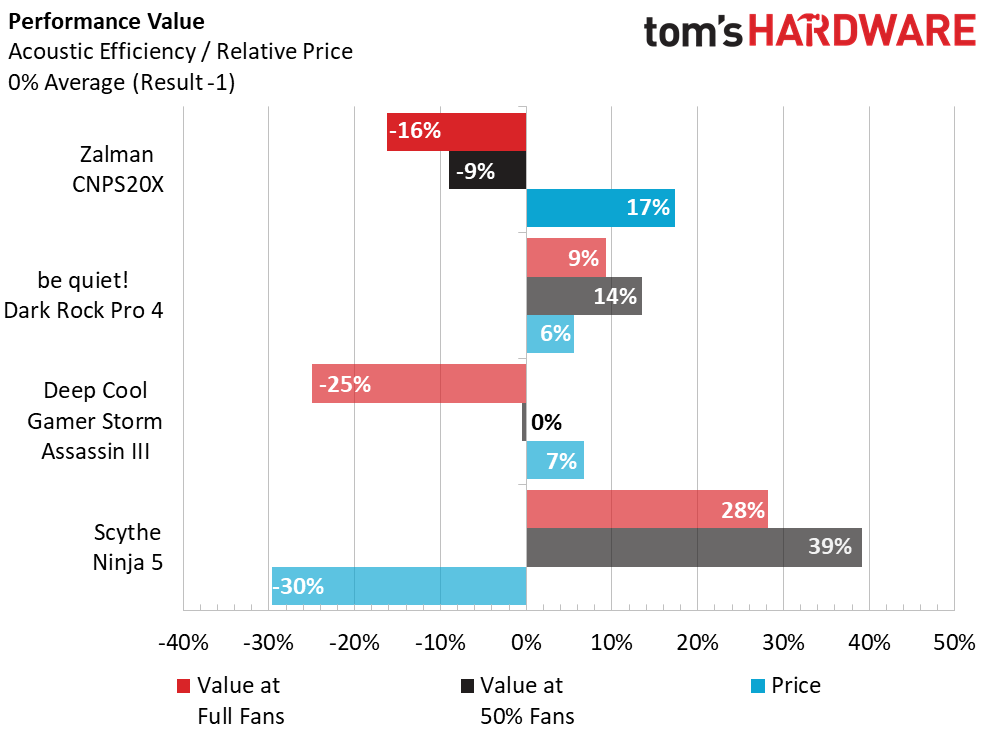Why you can trust Tom's Hardware
We will compare the Zalman CNPS20X with other larger heatpipe air coolers: the be quiet! Dark Rock Pro 4, Deep Cool’s Assassin III and the Scythe Ninja 5. Each have undergone testing on our six-core, Core i7 5930k clocked at 4.20Ghz and 1.20v on a MSI X99S XPower AC motherboard with 16GB of Crucial Ballistix DDR4-2400. Power is provided by a be quiet! 1200w Dark Power Pro inside a Corsair Graphite 760T chassis.
Note that while our cooling platform is old at this point, the CPU’s 140W TDP, combined with a healthy overclock, still gives today’s coolers a tough workout. That said, we are planning to update our cooling testbed once we can actually find a Core i9-10900K in stock at a price reasonably adjacent to its MSRP.
The Zalman CNPS20X performs on par with the be quiet! Dark Rock Pro 4 and the Deep Cool Assassin III at 100% fan speeds, while nothing keeps up with the Assassin III at 50%. It should be noted that while also a large air cooler, the Scythe Ninja 5 utilizes a pair of 120mm fans while the other coolers in the comparison group feature 135mm and 140mm fans.
The be quiet! Dark Rock Pro 4 features both a 135mm and 140mm fan, which is why it has two sets of fan data. Each of the other coolers makes use of a matched pair of fans of either 120mm or 140mm.
One primary benefit of large air cooling is (usually) very low registered decibel levels. The Zalman CNPS20X sits silently between the Dark Rock Pro 4 and the Ninja 5 in terms of ultra-low noise generation.
Acoustic efficiency gives us a glimpse as to how well a cooler performs under load when compared to how much noise is produced during that workload. Similar thermal load results and low decibel levels create beneficial charts for the CNPS20X and the Dark Rock Pro 4, while slightly elevated noise levels caused issues for the Assassin III, and higher thermal load results hindered the Scythe Ninja 5.
Adding unit price to our acoustic efficiency numbers, we end up with a performance value chrt, which provides some indication into how well a specific cooler performs in a dollar-for-dollar comparison. With a price of $100, the solid thermal performance and silent operation of the Zalman CNPS20X takes a performance value hit, as it’s the most expensive cooler in the comparison group, 17% above the group average price. Meanwhile, the Scythe Ninja 5 ends up with redeeming value due to its low price tag and silent operation, despite lagging behind the curve in thermal load testing.
Get Tom's Hardware's best news and in-depth reviews, straight to your inbox.
Thermal imaging from our FLIR ONE Pro camera shows some heat soak at both fan speeds, but overall, does indicate good dissipation of thermal load for both images. Consistency between the cooling towers is relatively balanced at 100% fan speed, while 50% fan speeds shows slight bias for the rear cooling tower over the front in our testing. Airflow channels are easily seen as darker, lateral paths on each image, indicating the effectiveness of thermal discharge via these areas.
Zalman’s CNPS20X is a solid of a cooler in terms of thermal performance, putting it on par with some of the best on the market today. Current pricing makes it a difficult recommendation, though, as it is priced higher than some of its peers while achieving very similar results. The unique design of the cooling tower with a very nice aesthetic touch in terms of contrasting metals, creating a look that isn’t available elsewhere. The 140mm cooling fans are ‘frameless’ in design and include 3-pin v5 aRGB lighting, but we also noticed they gave off a buzzing effect at higher rotation speeds.
Overall, the Zalman CNPS20X is a good alternative for those with the ability to stretch their budget a bit further with a focus on unique style. Otherwise, a slight price reduction of the CNPS20X to align it with the rest of the market would provide much greater value for the cooler and more appeal for system builders doing that last-minute shopping cart comparison.
MORE: Best CPU Cooling
MORE: How To Choose A CPU Cooler
MORE: All Cooling Content
- 1
- 2
Current page: Comparison Coolers, Testing Results and Conclusion
Prev Page Features and Specifications
Garrett Carver is a contributor for Tom’s Hardware, primarily covering thermal compound comparisons and CPU cooling reviews; both air and liquid, including multiple variations of each.





